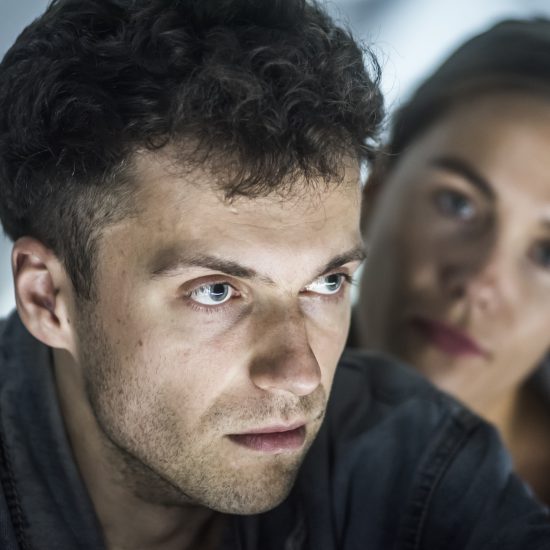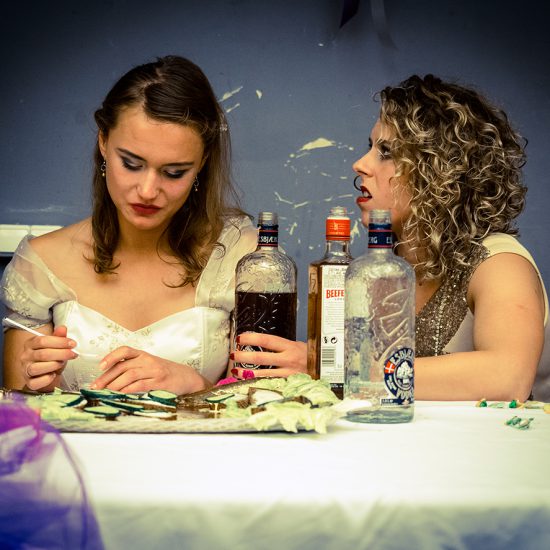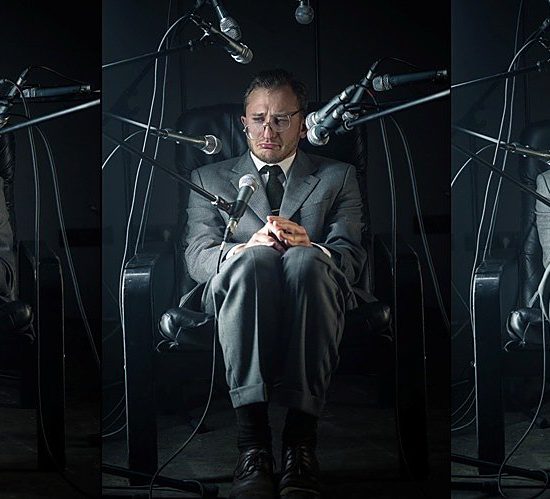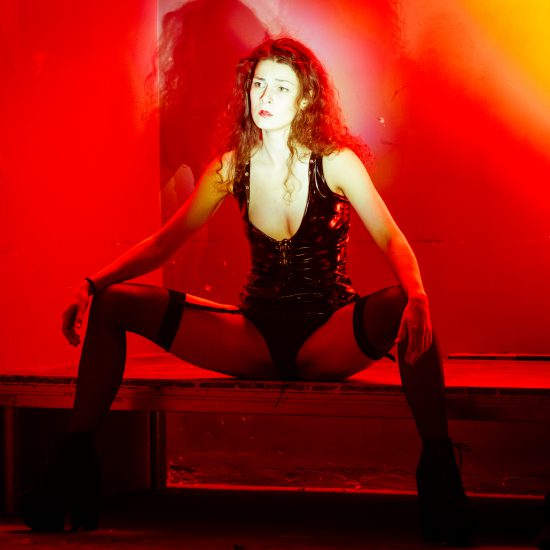The lower depths. The final stop of the route
“The Lower Depths” by Oskaras Koršunovas: The Post-Scriptum of “Hamlet”
A group of actors, crowding in a confined space, using only minimal means and only part of the dramaturgical text, in a short period of time, presented a small number of viewers with an event, whose meanings and allusions reach into much wider spaces and horizons. In order to understand all the gourmet ingredients one must be acquainted with the play as well as the director’s work (at least, his latest work), so the term “a closed evening” here can be interpreted rather literally: an unprepared viewer simply won’t be able to see all its merits. The Lithuanian Theatre, recently shocking the cultural space with its increasing kitschiness, now may be legitimately proud of having not just theater elite, but its particularly sophisticated model – the latest theatrical production by OKT.
<…>
<…> in front of the audience, along the wall, there’s a long white barrier that resembles a table. Behind it, we see the same actors as in “Hamlet” now sitting like some sports or pop stars. But, unlike in the other play, they do not examine their faces in the mirrors their backs turned to the audience, but, on the contrary, look straight into its eyes, the looks on their faces openly mocking it. Instead of the Hamletian question “Who are you?” the actors’ eyes are sending the following formidable message “We know who you are, and we know that you are nothing!”
On the barrier-table stand a few bottles of drinking water; on the plate – a scanty snack consisting of wafers resembling communion bread. The first impression – the scene is very reminiscent of Leonardo Da Vinci’s “Last Supper”. Gavenonis is the central figure, the “Messiah”, and at both of his sides are the “disciples” – Darius Meškauskas, Julius Žalakevičius, Darius Gumauskas, Rasa Samuolytė, Giedrius Savickas, Jonas Verseckas, and Tomas Žaibus. At his right, “next to the driver”, sit Nelė Savičenko and Rytis Saladžius. At once, we see it’s the same cast as in “Hamlet”.
Everybody waits for Gavenonis-Satine to say the first words from “The Lower Depths”. He does, silently, expressively, with an ironic smile, poking the finger at the audience’s face. At first, the actors speak like some superstars at a press conference, so full of themselves. The clinking of bottles coming from below the table betrays the “shadow” side of the “press conference”. “The Messiah” along with his immediate “apostles” secretly engages in bottling manipulations while, at the same time, carrying on their monologues for the audience and exchanging phrases from Gorky’s text among themselves. They gradually come to the surface and become open, as the tension and speed increase. Samuolytė’s character cracks Nastya’s monologue about love, supposedly full of drunken passion, Meškauskas, with a cynical and self-ironic smile, and an allegedly alcoholic tear in his eye delivers the story of his extraordinary past, and we hear the famous verbal duel between Nastya and the Baron. The verbal conflict develops into a theater of physical actions. There are screams and there is a fight, a plate gets smashed against the wall right above the Messiah’s head and the sacramental wafers are scattered on the table and among the viewers… The “Mass” is over. Darkness…
There’s a rule in theater directing: in order for new things to happen, there should be long periods of nothing happening. This method is called “a long walk”. The table mise-en-scène is exploited for about half an hour. The party at the table resembling the last supper, a mass, a press conference… The characters of this “table theatre” say their monologues like toasts; they gibe at each other, brawl and even cry…
The theatre plays a very dangerous game with the audience, nowadays so abused by the cabaret theatre, TV extravaganza, and monologues of commercial clowns… But there’s one fact, one constant “advantage” of acting that does not allow the spectators and the actors to be absorbed by this mindless frenzy. The advantage is the acceleration of the scenic time and space coded in the stage design, and – most importantly! – the ability to develop the theme of one’s own character, based on the excellent text by Maxim Gorky, continually demonstrated by the actors.
Then, lo and behold, a miracle happens: the same actors that played in “Hamlet” (i.e. the troupe of wandering actors, who played Hamlet, which, in turn, was played by the actors of OKT), with their temperaments, centrifugal force of acting and post-tragic ardor, have escaped from the Shakespearean plot to enter the finale of Maxim Gorky’s play about the underclass. The group of actors, traveling in time and space, finds absolution of their experiences in “Hamlet” in the last act of Gorky’s play (with certain insertions from other acts).
Parenthetically, the fourth act of the play was written as an epilogue. All the tragic events have already been played out and its main characters – Vasilisa, Vaska Pepel and the vagrant old man Luka – have already completed their presence in the previous plot. After the shocks they have suffered, the remaining residents of the kip house share their impressions and considerations. The lips of alcohol-drenched criminals and tramps who have sunk their souls in countless mutual humiliations, speak the words of humanity, freedom, and democracy, which deserve the most honorable rostrums of the state as well as meetings of the most glorified thinkers… Probably it was here that lay the shocking force of the fantastically suggestive drama, which stunned the public about a hundred years ago.
<…>
The directors of all the previously seen productions of “The Lower Depths” have usually stumbled on one question – what do the inhabitants of the lodging house do and what makes these people tick? This is not an easy question. As a rule, some chose the collective variant of “Waiting for Godot” while others set off on a search for symbolic or mystical meanings. It was incredibly boring to look at the naturally bored tramps on the stage…
At “The Lower Depths” created by Oskaras Koršunovas and his team, one doesn’t get bored for even a moment. The characters are killing the remains of their humanity in such an inspired, artistic, and selfless way that it develops into some kind of a trance, a crazed collective rampage, in which people yell and bellow instead of singing…
<…>
What is the meaning of this experiment? Undoubtedly, this is a farewell. To whom? Although still youthful and relatively (by the maturity standards of theater directors) young, Koršunovas is an artist of the elapsed century, who still appeals to the audience with his work and still expects a response that is no less passionate than the message coded in his performances. He can’t and won’t put up with the obvious fact that our theater is pushed (or pushes itself) to the margins of the artistic panorama and the periphery of the creative thought. In “The Lower Depths” the director transcends the mirrors of his “Hamlet” and demonstrates a kingdom behind them, in which even such an unsentimental artist as Koršunovas, to say the least, seems nothing but a naive idealist – a world, in which he, as an artist is forced to take on an entirely new and far more severe moral and creative confrontation. The director who has more than once created performances-manifestos (beginning with his first “Here to be There”) is again addressing the public with his creative farewell manifesto, drawing a sharp red line between the past and the future.
Yes, for every significant artist there comes the inevitable moment to say goodbye to something. This is the only way to remain oneself and keep going. And that is the law of creation, the persistent effort to create and be understood.



